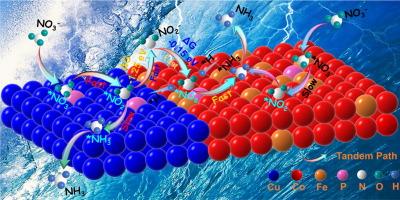Tandem catalysis over Cu@Co/CoFe-P metal-alloy heterostructure achieving ampere-level nitrate-to-ammonia electrosynthesis
IF 14.9
1区 化学
Q1 Energy
引用次数: 0
Abstract
The electrocatalytic reduction of nitrate to ammonia (NO3−RR) offers a sustainable alternative to energy-intensive industrial NH3 synthesis. Tandem catalysis has shown promise in overcoming the multi-step complexity of NO3−RR, yet challenges remain in optimizing performance and elucidating tandem mechanisms. Herein, we report a Cu@Co/CoFe-P tandem electrocatalyst featuring a phosphorus-doped heterostructure with dual active sites (Cu-P and Co/CoFe-P). This catalyst achieves an exceptional NH3 yield of 175.40 mg h−1 cm−2 and a record-high current density exceeding 2 A cm−2, with the electro-synthesized NH3 directly converted into NH4Cl. In situ spectroscopic analysis and density functional theory (DFT) calculations reveal a novel desorption-reactivation tandem mechanism: (1) the Cu-P domain preferentially reduces NO3− to *NO2, which desorbs as stable NO2−; (2) the Co/CoFe-P domain subsequently reactivates NO2−, and converts it efficiently into NH3. Moreover, phosphorus doping enhances *H supply, while Fe alloying with Co promotes NO2− hydrogenation, ensuring an efficient and synchronized tandem pathway for NO3−RR. The proposed *NO2 desorption-reactivation mechanism deepens the understanding of NO3−RR tandem process, thereby paving the way for designing more efficient tandem electrocatalysts.

在Cu@Co/咖啡- p金属合金异质结构上的串联催化实现安培级硝酸盐-氨电合成
硝酸电催化还原制氨(NO3 - RR)为能源密集型工业氨合成提供了可持续的替代方案。串联催化已显示出克服NO3−RR多步骤复杂性的希望,但在优化性能和阐明串联机制方面仍存在挑战。本文报道了一种Cu@Co/ coffee - p串联电催化剂,其具有磷掺杂异质结构,具有双活性位点(Cu-P和Co/ coffee - p)。该催化剂的NH3产率达到175.40 mg h−1 cm−2,电流密度超过2 a cm−2,电合成的NH3直接转化为NH4Cl。原位光谱分析和密度泛函理论(DFT)计算揭示了一种新的脱附-再活化机制:(1)Cu-P结构域优先将NO3−还原为*NO2,并以稳定的NO2−解吸;(2) Co/ fe - p结构域随后重新激活NO2 -,并将其有效地转化为NH3。此外,磷的掺杂增加了*H的供应,而Fe与Co的合金化促进了NO2−的氢化,确保了NO3−RR的高效同步串联途径。提出的*NO2解吸-再活化机理加深了对NO3−RR串联工艺的认识,从而为设计更高效的串联电催化剂铺平了道路。
本文章由计算机程序翻译,如有差异,请以英文原文为准。
求助全文
约1分钟内获得全文
求助全文
来源期刊

Journal of Energy Chemistry
CHEMISTRY, APPLIED-CHEMISTRY, PHYSICAL
CiteScore
19.10
自引率
8.40%
发文量
3631
审稿时长
15 days
期刊介绍:
The Journal of Energy Chemistry, the official publication of Science Press and the Dalian Institute of Chemical Physics, Chinese Academy of Sciences, serves as a platform for reporting creative research and innovative applications in energy chemistry. It mainly reports on creative researches and innovative applications of chemical conversions of fossil energy, carbon dioxide, electrochemical energy and hydrogen energy, as well as the conversions of biomass and solar energy related with chemical issues to promote academic exchanges in the field of energy chemistry and to accelerate the exploration, research and development of energy science and technologies.
This journal focuses on original research papers covering various topics within energy chemistry worldwide, including:
Optimized utilization of fossil energy
Hydrogen energy
Conversion and storage of electrochemical energy
Capture, storage, and chemical conversion of carbon dioxide
Materials and nanotechnologies for energy conversion and storage
Chemistry in biomass conversion
Chemistry in the utilization of solar energy
 求助内容:
求助内容: 应助结果提醒方式:
应助结果提醒方式:


